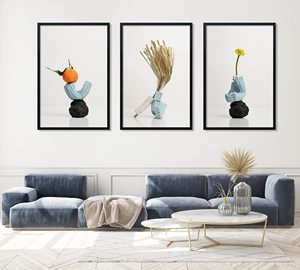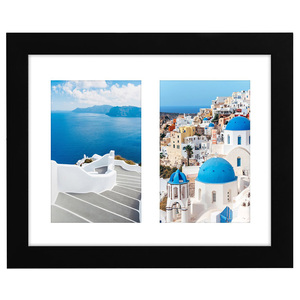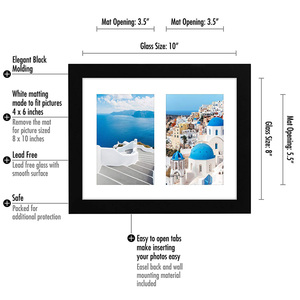Types of 30×40 picture frames
A 30×40 picture frame is a decorative border designed to hold and display a 30×40 centimeter picture or artwork. These frames come in various styles, materials, and colors to complement different types of decor and personal preferences. The main components of a picture frame include the molding, mat, backing, and glass or plastic cover. The molding is the outer part that gives the frame its shape and style. It can be made from wood, metal, or plastic and come in various designs, from ornate to sleek and modern. The mat is an optional element, typically a piece of paper or cardboard placed behind the artwork or photo within the frame designed to accentuate the displayed item and create a visual border. The backing provides support and protection for the artwork, while the glass or plastic cover protects the artwork from dust and damage.
30×40 picture frames are popular choices for displaying artwork, photos, and certificates. They are big enough to make a statement but not so large as to overwhelm a room. The frame's size is usually measured in centimeters, making it ideal for showcasing posters or larger prints. Different types of 30×40 picture frames are available on the market, each with unique features and benefits. They can be classified based on the material used in their construction, such as wood, metal, glass, or plastic.
- Wooden frames: These are usually made from solid wood, such as oak, pine, or mahogany. They are known for their natural beauty and durability. Wooden frames have a classic look that never goes out of style. They are available in various finishes, including painted or stained. Wooden frames are versatile and fit well in any decor.
- Metal frames: Metal frames are sleek and modern. They are usually made from aluminum or other metals. These frames are lightweight and strong, with clean lines and a contemporary look. Metal frames are also available in various colors, including black, silver, and gold.
- Glass frames: Glass frames offer a sophisticated and elegant look. They are usually heavy and durable, with a clear glass front that protects the artwork. They have a polished and shiny finish that can make any artwork look more important. Glass frames are perfect for displaying valuable paintings or photos.
- Plastic frames: Plastic frames are affordable and lightweight. They are available in various colors and designs. Plastic frames are easy to clean and maintain, making them suitable for high-traffic areas. They are also great for children's rooms or casual settings.
- Acrylic frames: Acrylic frames are a popular alternative to glass frames. Acrylic is a transparent thermoplastic often used in place of glass. Acrylic frames are lightweight and shatter-resistant, making them a safer option for homes with children or pets. They offer a modern and sleek look and are easy to clean and maintain.
- Shadow box frames: Shadow box frames are deep frames that allow for the display of three-dimensional objects. They are typically used to showcase memorabilia, medals, jewelry, and other keepsakes. Shadow box frames have a glass front and often come with adjustable mounting boards inside to arrange the displayed items.
- Collage frames: Collage frames are designed to hold multiple pictures or a combination of pictures and other items. They come in various sizes and styles, allowing for different arrangements. Collage frames are great for creating a themed display, such as family photos or travel memories.
Design of 30×40 picture frames
- Moulding: The frame moulding is the part of the frame that borders the picture. It is available in a variety of depths and widths ranging from 30 mm to 40 mm. The moulding comes in an array of colors, including black, white, silver, and gold, to match any decor. The colors are usually available in a variety of textures, such as glossy, metallic, or matte. Some frame mouldings are carved with intricate designs, while others are plain and simple. They are made from materials like wood, metal, or plastic.
- Mat board: A 30×40 picture frame mat board provides a visual resting space and accentuates the artwork or photo. It is available in several colors, thicknesses, and textures. The most commonly used material for mat boards is acid-free and lignin-free. They are available in colors ranging from white, black, and cream to custom shades that can complement or contrast the framed piece. Textured mat boards can add depth, while smooth ones offer a clean look. They are available in various thicknesses, such as 1/16 inch and 1/8 inch.
- Glass or acrylic: The glazing of the 30×40 picture frames is the glass or acrylic that covers the artwork. Regular glass is available along with options like UV-protective glass, anti-reflective glass, and shatterproof glass. The UV-protective glazing helps prevent colors from fading due to sunlight exposure. Anti-reflective glazing reduces glare, making it easier to see the artwork in brightly lit rooms. Shatterproof glazing is ideal for high-traffic areas or homes with children.
- Backing board: The backing board is the frame's last component, providing support and protection. It is made of cardboard or foam board and keeps the picture from bending or getting wet. Some backing boards are acid-free to protect the artwork better. They also have dust covers on the back to keep frames clean and free of dust.
Scenarios of 30×40 picture frames
-
Living room focal point
Living rooms usually have the most space, making them ideal for showcasing art and larger family pictures. A 30×40 picture frame holding a beautiful painting or a large family picture can make a living room more welcoming and stylish.
-
Home office inspiration
A 30×40 frame in a home office may hold an inspiring quote, a degree, or a certificate. It can also carry a blueprint or a map if the work involves architecture, engineering, or geology. Such prints motivate and orient the worker, making them more productive.
-
Bedroom ambiance
In bedrooms, 30×40 frames can hold romantic pictures, serene landscapes, or personal artwork that evoke peace and intimacy. These frames contribute to a calm atmosphere, perfect for rest and rejuvenation.
-
Dining room décor
The dining room is where people gather to eat and socialize, so it's a good place for art and pictures. A 30×40 frame with food-related art or a large picture of the family enjoying a meal can create a warm, communal vibe.
-
Entryway impact
The entryway sets the tone for the entire home. A 30×40 frame in this space instantly grabs attention. It could be a striking piece of art or a collection of smaller frames in 30×40 sizes, perhaps showcasing a family portrait or a favorite landscape.
-
Basement escape
Large frames in the basement can transform it into an escape. Whether it's a movie poster, a print of a favorite band, or a large-scale photo, the frame makes the space cozier and more inviting.
-
Outdoor elegance
In outdoor spaces, 30×40 frames can withstand the elements better if they are designed for it. Framed artwork or photos can make patios or decks feel like extended living rooms. It could be a frame with a picture of a memorable outdoor family event, reminding everyone to enjoy life outside the home.
How to choose a 30×40 picture frame
When choosing a frame for a 30×40 picture, consider the following:
- Size and orientation: Select a frame that matches the picture's size and orientation. The frame should be for a 30×40 picture, either landscape or portrait.
- Matter: The frame should complement the picture. A wood frame gives a natural look, metal offers a modern vibe, and plastic is affordable and diverse.
- Frame style: The frame's design should fit the place. A classic frame suits traditional decor, a canvas float frame 30x40 for modern decor, and an ornate frame for glamor.
- Border width: The frame's border should not cover the picture. Select a border that enhances the visual presentation.
- Glass vs. acrylic: Glass is heavy but clear and scratch-resistant. Acrylic is lightweight and shatterproof. Choose based on installation ease and safety needs.
- Matting: A mat can add a visual border and protect the artwork from touching the frame glass. Choose one that complements both the picture and the frame.
- Protection: UV-protective glazing prevents fading in sunlight. Use it for valuable or sun-exposed artworks. The shadow box adds depth and room for objects.
- Hanging hardware: Ensure the frame has the necessary hardware for easy installation. Some frames might have stands for tabletops.
- Cost: Frames vary in cost. Designer frames cost more, and bulk frames are cheaper. Custom frames cost more than standard frames.
Q&A
Q1. What is the benefit of having a 30x40 picture frame in plastic as compared to wood?
A1. A 30x40 plastic picture frame is advantageous because it is economical and can come in various colors.
Q2. What is the purpose of a 30x40 frame?
A2. A 30x40 frame is designed to hold artwork or images that measure 30 inches by 40 inches. The frame makes the artwork look better and protects it.
Q3. What looks good in a 30x40 frame?
A3. Many things can be put in a 30x40 frame, but they usually suit big pictures, paintings, or certificates.
Q4. What is the difference between 30x40 frames and posters?
A4. Posters are printed papers that advertise or provide information, while frames are used to protect and display posters or pictures.
Q5. What should be the distance between two 30x40 frames?
A5. The distance between two frames should be at least 2-3 feet so that they can be viewed from a distance.














































































































































































































